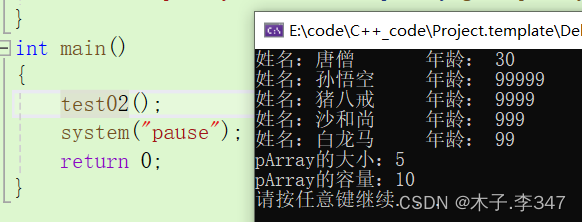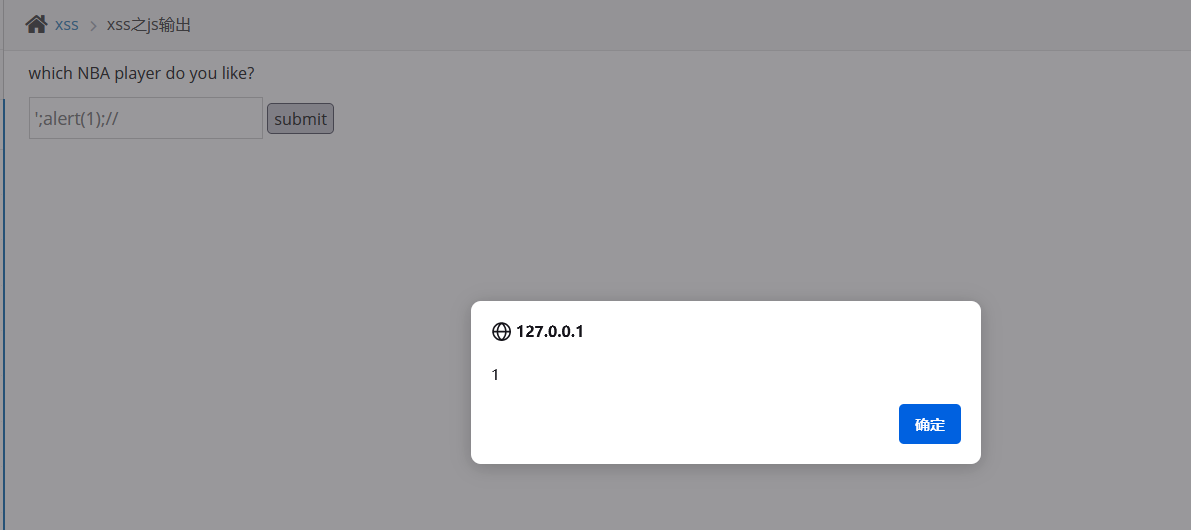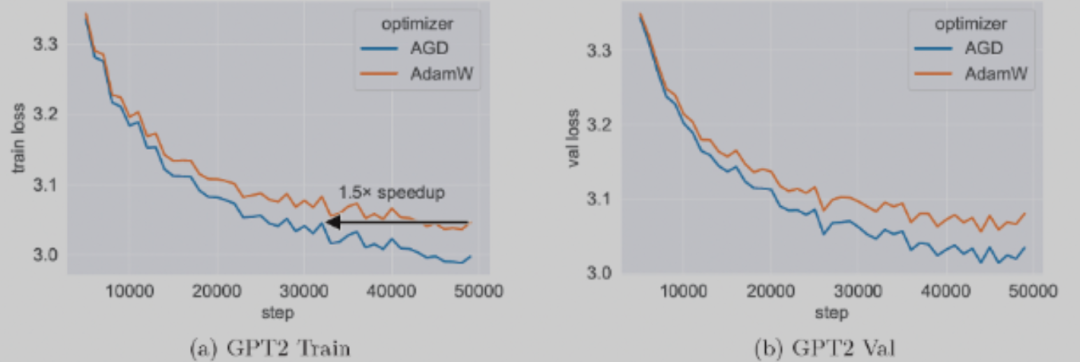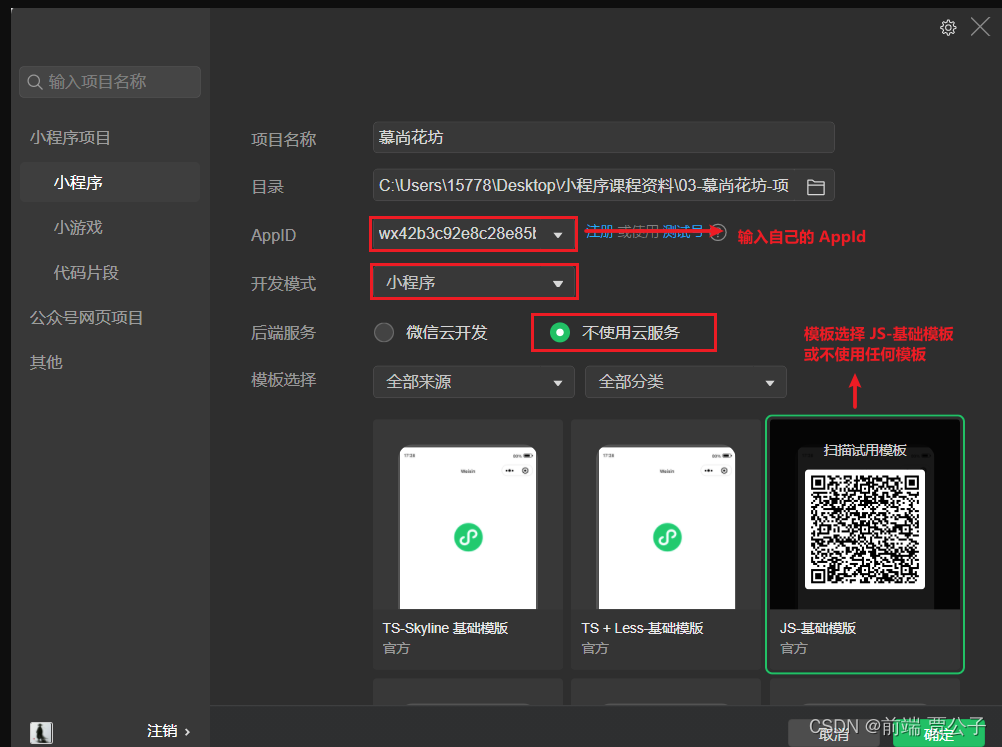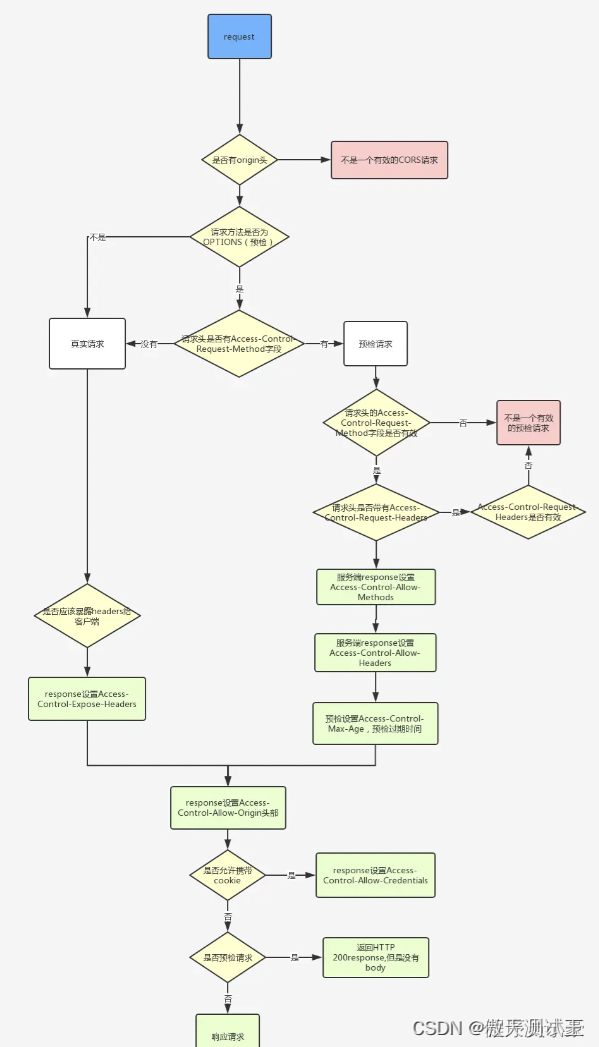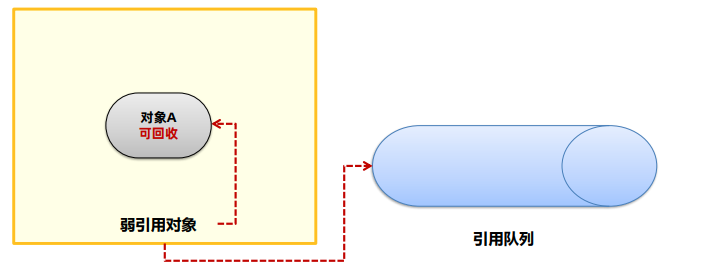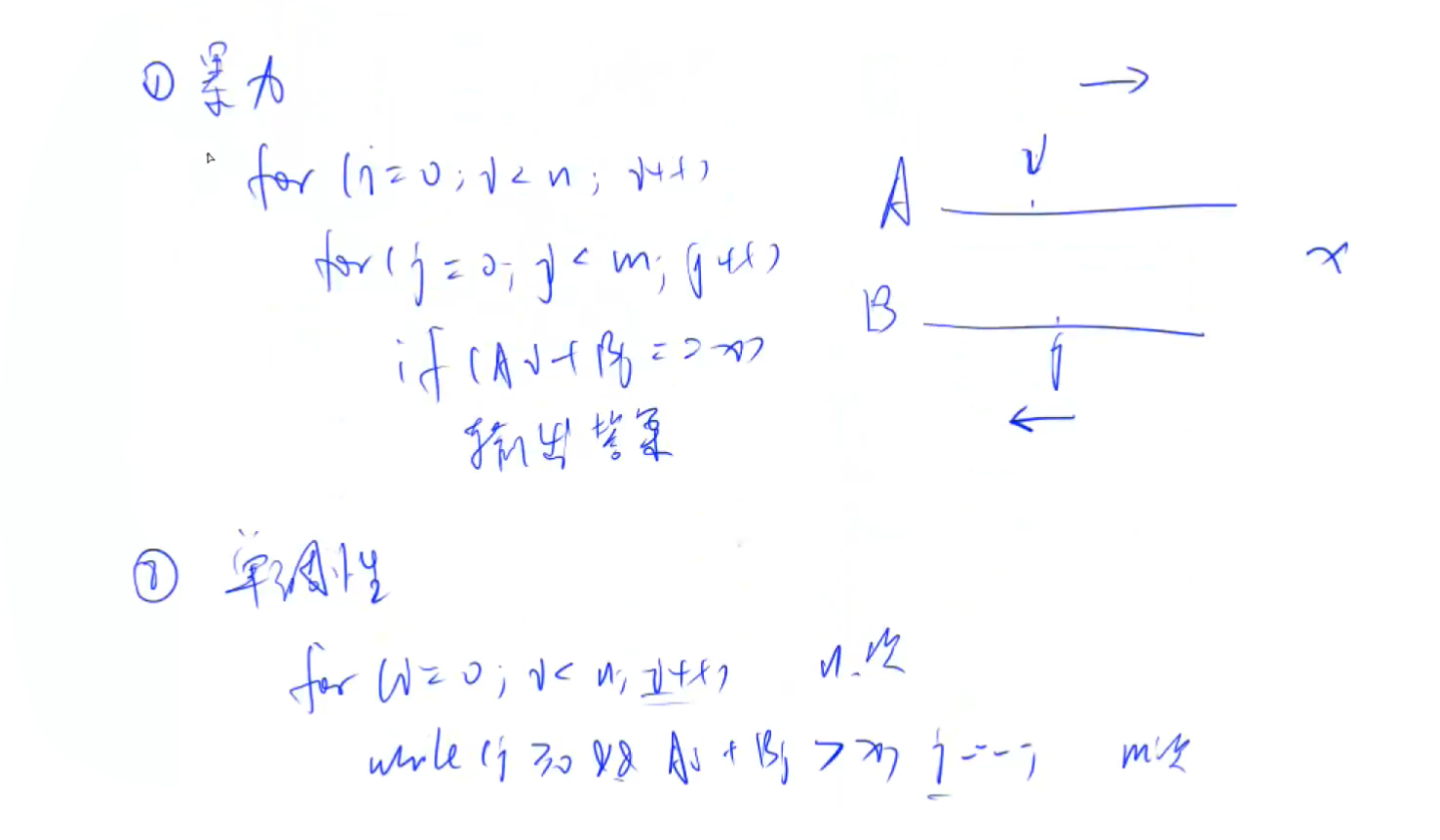模板目录
- 2.类模板
- 2.1 类模板语法
- 2.2 类模板与函数模板区别
- 2.3 类模板中成员函数创建时机
- 2.4 类模板对象做函数参数
- 2.5 类模板与继承
- 2.6 类模板成员函数类外实现
- 2.7 类模板分文件编写
- 2.8 类模板与友元
- 2.9 类模板案例

2.类模板
2.1 类模板语法
类模板作用:
- 建立一个通用类,类中的成员数据类型可以不具体制定,用一个虚拟的类型来代表。
语法:
template<class T>
类
解释:
template — 声明创建模板
typename — 表面其后面的符号是一种数据类型,可以用class代替
T —通用的数据类型,名称可以替换,通常为大写字母
示例:
template <typename T1,typename T2>
class Person
{
public:
Person(T1 name, T2 age)
{
this->m_name = name;
this->m_age = age;
}
void print()
{
cout << "姓名:" << this->m_name << " 年龄:" << this->m_age << endl;
}
public:
T1 m_name;
T2 m_age;
};
void test01()
{
// 指定T1 为string类型,T2 为 int类型
Person<string, int>p1("李四", 25);
p1.print();
}
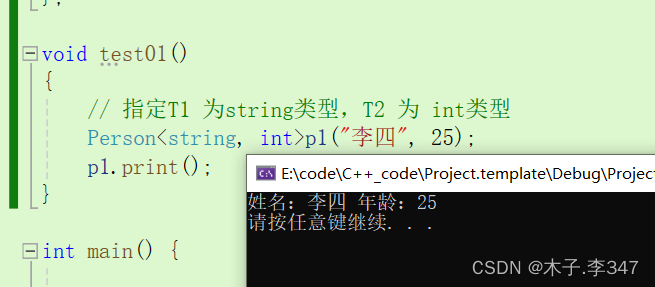
总结:类模板和函数模板语法相似,在声明模板template后面加类,此类称为类模板。
2.2 类模板与函数模板区别
类模板与函数模板区别主要有两点:
- 类模板没有自动类型推导的使用方式
- 类模板在模板参数列表中可以有默认参数
示例:
template <typename T1,typename T2=int>
class Person
{
public:
Person(T1 name, T2 age)
{
this->m_name = name;
this->m_age = age;
}
void print()
{
cout << "姓名:" << this->m_name << " 年龄:" << this->m_age << endl;
}
public:
T1 m_name;
T2 m_age;
};
void test02()
{
// 指定T1 为string类型,T2 为 int类型(可省)
Person<string>p1("李四", 25);//不写则默认
p1.print();
//对于默认类型参数可变
Person<string, char>p2("张三", 'A');
p2.print();
}
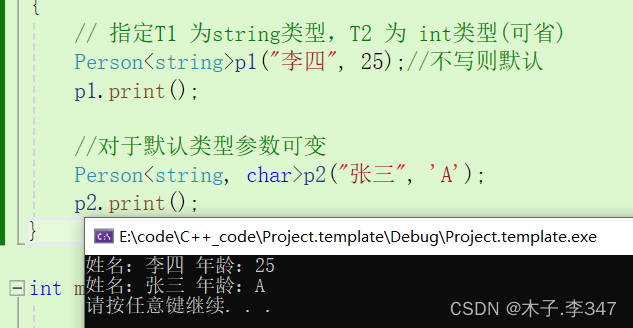
总结:
- 类模板使用只能用
显示指定类型方式; - 类模板中的模板参数列表
可以有默认参数.
2.3 类模板中成员函数创建时机
类模板中成员函数和普通类中成员函数创建时机是有区别的:
- 普通类中的成员函数
一开始就可以创建; - 类模板中的成员函数
在调用时才创建;
示例:
class Person1
{
public:
void print1()
{
cout << "普通类成员函数---1" << endl;;
}
};
class Person2
{
public:
void print2()
{
cout << "普通类成员函数---2" << endl;;
}
};
template <class T>
class ClassTemplate
{
public:
T mem;
//类模板中的成员函数,并不是一开始就创建的,而是在模板调用时再生成
void func1()
{
mem.print1();
}
void func2()
{
mem.print2();
}
};
void test02()
{
ClassTemplate<Person1>p1;
p1.func1();//函数调用
//p1.func2();//编译会出错,说明函数调用才会去创建成员函数
}

说明:对于普通类成员函数,当创建对象时就可以调用成员函数;对于类模板,利用其创建对象后,如果其成员函数是一开始就创建,则创建对象后就可调用,但对于func2()函数却不可调用,只有在创建相应对象后才可以调用相应成员函数.
2.4 类模板对象做函数参数
学习目标:
- 类模板实例化出的对象,向函数传参的方式;
一共有三种传入方式:
- 指定传入的类型 — 直接显示对象的数据类型;
- 参数模板化 — 将对象中的参数变为模板进行传递;
- 整个类模板化 — 将这个对象类型模板化进行传递.
示例1:
template <typename T1, typename T2 = int>//默认参数
class Person
{
public:
Person(T1 name, T2 age)
{
this->m_name = name;
this->m_age = age;
}
void print()
{
cout << "姓名:" << this->m_name << " 年龄:" << this->m_age << endl;
}
public:
T1 m_name;
T2 m_age;
};
//1. 指定传入的类型-- - 直接显示对象的数据类型;
void func(Person<string>& p)
{
p.print();
}
void test01()
{
Person<string>p1("李四", 25);//不写则默认
func(p1);
}
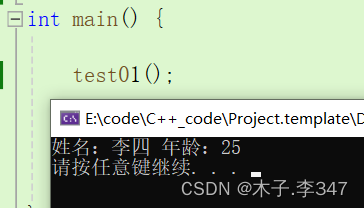
示例2:
template <typename T1, typename T2 = int>//默认参数
class Person
{
public:
Person(T1 name, T2 age)
{
this->m_name = name;
this->m_age = age;
}
void print()
{
cout << "姓名:" << this->m_name << " 年龄:" << this->m_age << endl;
}
public:
T1 m_name;
T2 m_age;
};
//2. 参数模板化-- - 将对象中的参数变为模板进行传递;(函数模板)
template<class T1,class T2>
void func1(Person<T1,T2>& p)
{
p.print();
//输出模板参数类型
cout << "T1的类型为: " << typeid(T1).name() << endl;
cout << "T2的类型为: " << typeid(T2).name() << endl;
}
void test02()
{
Person<string>p1("唐僧", 99);//不写则默认
func1(p1);
}

示例3:
template <typename T1, typename T2 = int>//默认参数
class Person
{
public:
Person(T1 name, T2 age)
{
this->m_name = name;
this->m_age = age;
}
void print()
{
cout << "姓名:" << this->m_name << " 年龄:" << this->m_age << endl;
}
public:
T1 m_name;
T2 m_age;
};
//3. 整个类模板化-- - 将这个对象类型模板化进行传递.
template<class T>
void func2(T& p)
{
p.print();
//输出模板参数类型
cout << "T的类型为: " << typeid(T).name() << endl;
}
void test03()
{
Person<string>p1("孙悟空", 999);//不写则默认
func2(p1);
}

总结:
- 通过类模板创建的对象,可以有三种方式向函数中进行传参
- 使用比较广泛是第一种:指定传入的类型
2.5 类模板与继承
当类模板碰到继承时,需要注意一下几点:
- 当子类继承的父类是一个类模板时,子类在声明的时候,要指定出父类中T的类型;
- 如果不指定,编译器无法给子类分配内存;
- 如果想灵活指定出父类中T的类型,子类也需变为类模板.
示例1:
//普通子类继承模板父类
template <class T>
class Base
{
public:
T m;
};
//c++编译需要给子类分配内存,必须知道父类中T的类型才可以向下继承
class Son :public Base<int>
{
public:
void func()
{
cout << "Son类成员函数" << endl;
}
};

示例2:
//模板子类继承模板父类
template <class T>
class Base
{
public:
T m;
};
//如果想灵活指定出父类中T的类型,子类也需变为类模板
template <class T1, class T2 >
class Son :public Base<T2>
{
public:
void func()
{
cout << "Son类成员函数" << endl;
cout << "T1的类型为: " << typeid(T1).name() << endl;
cout << "T2的类型为: " << typeid(T2).name() << endl;
}
};

2.6 类模板成员函数类外实现
注意与普通类成员函数的类外实现对比记忆.
示例:
template <typename T1, typename T2>
class Person
{
public:
//成员函数类内声明
Person(T1 name, T2 age);
void print();
public:
T1 m_name;
T2 m_age;
};
//构造函数 类外实现
template <typename T1, typename T2>
Person<T1,T2>::Person(T1 name, T2 age)
{
this->m_name = name;
this->m_age = age;
}
//成员函数 类外实现
template <typename T1, typename T2>
void Person<T1, T2>::print()
{
cout << "姓名:" << this->m_name << " 年龄:" << this->m_age << endl;
}
void test01()
{
Person<string, int>p1("孙悟空", 999);
p1.print();
}
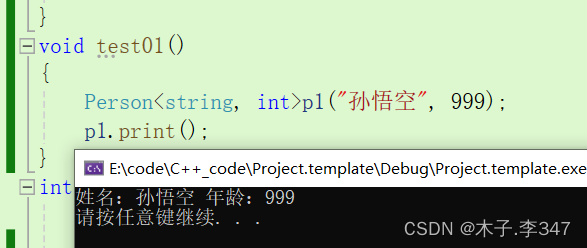
总结:类模板中成员函数类外实现时,需要加上模板参数列表
2.7 类模板分文件编写
问题:
- 类模板中成员函数创建时机是在调用阶段,导致分文件编写时链接不到;
解决:
- 解决方式1:直接包含.cpp源文件;
- 解决方式2:将声明和实现写到同一个文件中,并更改后缀名为.hpp,hpp是约定的名称,并不是强制.
解决方式1:直接包含.cpp源文件
示例1:
template.cpp:
#include "template.h"
//构造函数 类外实现
template <typename T1, typename T2>
Person<T1, T2>::Person(T1 name, T2 age)
{
this->m_name = name;
this->m_age = age;
}
//成员函数 类外实现
template <typename T1, typename T2>
void Person<T1, T2>::print()
{
cout << "姓名:" << this->m_name << " 年龄:" << this->m_age << endl;
}
template.h:
#pragma once
#include <iostream>
using namespace std;
template <typename T1, typename T2>
class Person
{
public:
//成员函数类内声明
Person(T1 name, T2 age);
void print();
public:
T1 m_name;
T2 m_age;
};
#include "template.cpp"
void test01()
{
Person<string, int>p1("孙悟空", 999);
p1.print();
}
int main() {
test01();
system("pause");
return 0;
}

解决方式2:将声明和实现写到同一个文件中,并更改后缀名为.hpp,hpp是约定的名称,并不是强制
示例2:
template.hpp://后缀可改
#pragma once
#include <iostream>
using namespace std;
template <typename T1, typename T2>
class Person
{
public:
//成员函数类内声明
Person(T1 name, T2 age);
void print();
public:
T1 m_name;
T2 m_age;
};
//构造函数 类外实现
template <typename T1, typename T2>
Person<T1, T2>::Person(T1 name, T2 age)
{
this->m_name = name;
this->m_age = age;
}
//成员函数 类外实现
template <typename T1, typename T2>
void Person<T1, T2>::print()
{
cout << "姓名:" << this->m_name << " 年龄:" << this->m_age << endl;
}
#include "template.hpp"
void test01()
{
Person<string, int>p1("孙悟空", 999);
p1.print();
}
int main() {
test01();
system("pause");
return 0;
}

2.8 类模板与友元
- 全局函数类内实现 - 直接在类内声明友元即可;
- 全局函数类外实现 - 需要提前让编译器知道全局函数的存在;
示例1:
- 全局函数类内实现—友元
//类模板
template <class T1, class T2>
class Person
{
//1、全局函数配合友元 类内实现
friend void print1(Person<T1, T2>& p)
{
cout << "姓名: " << p.m_name << " 年龄:" << p.m_age << endl;
}
public:
Person(T1 name, T2 age)
{
this->m_name = name;
this->m_age = age;
}
private:
T1 m_name;
T2 m_age;
};
void test01()
{
Person<string, int>p1("沙和尚", 100);
print1(p1);
}

示例2:
- 全局函数类外实现—友元
//全局函数配合友元 类外实现 - 先做类模板声明,下方在做函数模板定义,在做友元
template<class T1, class T2>
class Person;//类模板声明
//全局函数类外实现
template<class T1, class T2>
void print2(Person<T1, T2>& p)//此处用到Person类,需要在前面声明
{
cout << "类外实现 ---- 姓名: " << p.m_name << " 年龄:" << p.m_age << endl;
}
//类模板
template <class T1, class T2>
class Person
{
//2、全局函数配合友元 类外实现
//注意此处print2后的<>,这个空模板列表是为了告诉编译器这是一个函数模板的声明,不是普通函数声明
friend void print2<>(Person<T1, T2>& p);
public:
Person(T1 name, T2 age)
{
this->m_name = name;
this->m_age = age;
}
private:
T1 m_name;
T2 m_age;
};
void test02()
{
Person<string, int>p1("孙悟空", 9999);
print2(p1);
}

总结:建议全局函数做类内实现,用法简单,而且编译器可以直接识别
2.9 类模板案例
案例描述: 实现一个通用的数组类,要求如下:
- 可以对内置数据类型以及自定义数据类型的数据进行存储
- 将数组中的数据存储到堆区
- 构造函数中可以传入数组的容量
- 提供对应的拷贝构造函数以及operator=防止浅拷贝问题
- 提供尾插法和尾删法对数组中的数据进行增加和删除
- 可以通过下标的方式访问数组中的元素
- 可以获取数组中当前元素个数和数组的容量
分文件编写:
myArray.hpp中代码
示例1:
#pragma
#include <iostream>
using namespace std;
template<class T>
class MyArray
{
public:
//构造函数
MyArray(int capacity)
{
this->m_Capacity = capacity;
this->m_Size = 0;
this->pAddress = new T[this->m_Capacity];
}
//拷贝构造
MyArray(const MyArray& arr)
{
this->m_Capacity = arr.m_Capacity;
this->m_Size = arr.m_Size;
//深拷贝
this->pAddress = new T[this->m_Capacity];//重新开辟堆区空间
//将arr中原有内容拷贝
for (int i = 0; i < this->m_Size; i++)
{
//如果T为对象,而且还包含指针,必须需要重载 = 操作符,因为这个等号不是 构造 而是赋值,
// 普通类型可以直接= 但是指针类型需要深拷贝
this->pAddress[i] = arr.pAddress[i];
}
}
//重载= 操作符 防止浅拷贝问题
MyArray& operator=(const MyArray& myarray) {
//先对被赋值的对象进行判断是否为空
if (this->pAddress != NULL) {
delete[] this->pAddress;
this->m_Capacity = 0;
this->m_Size = 0;
}
this->m_Capacity = myarray.m_Capacity;
this->m_Size = myarray.m_Size;
//防止浅拷贝,进行深拷贝
this->pAddress = new T[this->m_Capacity];
for (int i = 0; i < this->m_Size; i++) {
this->pAddress[i] = myarray.pAddress[i];
}
return *this;
}
//重载[] 操作符
//通过下标方式访问数组元素
//由于自己所创建的是一个类arr,类无法实现与[]结合表示数组元素
//需要进行[]重载,返回T&表示可以对arr[index]赋值,及arr[index]=100
T& operator[](int index)
{
return this->pAddress[index]; //不考虑越界,用户自己去处理
}
//尾插法
void Push_back(const T& value)
{
if (this->m_Capacity == this->m_Size)
{
return;
}
this->pAddress[this->m_Size] = value;
this->m_Size++;
}
//尾删法
void Pop_back()
{
if (this->m_Size == 0)
{
return;
}
this->m_Size--;
}
//获取数组容量
int getCapacity()
{
return this->m_Capacity;
}
//获取数组大小
int getSize()
{
return this->m_Size;
}
//析构
~MyArray()
{
if (this->pAddress != NULL)
{
delete[] this->pAddress;
this->pAddress = NULL;
this->m_Capacity = 0;
this->m_Size = 0;
}
}
private:
T* pAddress; //指向一个堆空间,这个空间存储真正的数据
int m_Capacity; //容量
int m_Size; // 大小
};
类模板案例—数组类封装.cpp中
示例2.1:
#include "myArray.hpp"
void print_Array(MyArray<int>& arr)
{
for (int i = 0; i < arr.getSize(); i++) {
cout << arr[i] << " ";
}
cout << endl;
}
//测试内置数据类型
void test01()
{
MyArray<int>arr1(10);
for (int i = 0; i < 10; i++)
{
arr1.Push_back(i);
}
cout << "arr1打印输出:" << endl;
print_Array(arr1);
cout << "arr1的大小:" << arr1.getSize() << endl;
cout << "arr1的容量:" << arr1.getCapacity() << endl;
cout << "--------------------------" << endl;
MyArray<int> arr2(arr1);
arr2.Pop_back();
cout << "arr2打印输出:" << endl;
print_Array(arr2);
cout << "arr2的大小:" << arr2.getSize() << endl;
cout << "arr2的容量:" << arr2.getCapacity() << endl;
}
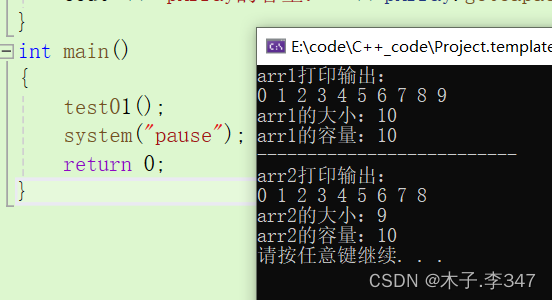
示例2.2:
class Person
{
public:
Person() {};//防止创建无参数类时,缺少无参构造
Person(string name, int age) {
this->m_Name = name;
this->m_Age = age;
}
public:
string m_Name;
int m_Age;
};
void print_class_Array(MyArray<Person>& personArr)
{
for (int i = 0; i < personArr.getSize(); i++) {
cout << "姓名:" << personArr[i].m_Name <<"\t"<< " 年龄: " << personArr[i].m_Age << endl;
}
}
//测试自定义数据类型
void test02()
{
//创建数组
MyArray<Person> pArray(10);
Person p1("唐僧", 30);
Person p2("孙悟空", 99999);
Person p3("猪八戒", 9999);
Person p4("沙和尚", 999);
Person p5("白龙马", 99);
//插入数据
pArray.Push_back(p1);
pArray.Push_back(p2);
pArray.Push_back(p3);
pArray.Push_back(p4);
pArray.Push_back(p5);
print_class_Array(pArray);
cout << "pArray的大小:" << pArray.getSize() << endl;
cout << "pArray的容量:" << pArray.getCapacity() << endl;
}
